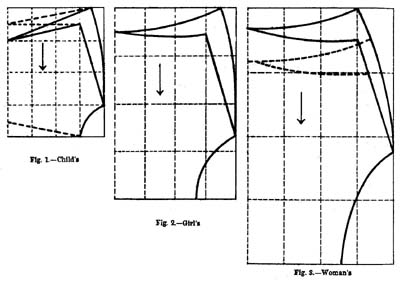DRAWERS AND KNICKERBOCKERS
This is the most difficult type of garment to take measures for, especially measures of width, and a good deal of the calculation of proportions must be done by referring to patterns or garments already made. It is scarcely possible in this case to demonstrate the correctness of the proportions before the pupils as in the case of the other garments.
The differences in proportion between children's and women's drawers are caused (1) by the differences of bodily form, the child having relatively a much shorter leg, and (2) by the manner in which the clothes are worn. The child's knickers do not often reach to the knee, while girls' and women's knickers must have the bands below the knee, and allow plenty of room for bending the knee.
The length may be measured in two ways: (1) Measure from waist at back to knee, with leg bent so as to get the longest possible measure; (2) measure from waist to knee (front) and take one and a half times the length measured. The first method is the better, as the pupils can see exactly what is required.
The width varies in proportion to length according, to the age of the wearer. The child's type (i.e. up to eight years of age) has width equal to one and a half times length, the girl's type width equal to one and one-third or one and one-fourth times length, while the woman's type has width not much greater than length, usually the width of the material is sufficient.
The length of leg in proportion to body also varies with the age of the wearer. In the child's type the leg occupies one-fourth of the whole length, in the girl's type one-third, and in the woman's type nearly a half.
The attention of the pupils should be directed to the shape of the various lines of the pattern.
The leg curve is best cut while the material is double, so that the two sides may be identical. It should be started at right angles to the direction of the front curve, and brought down at right angles to the bottom line.
The back of the garment is wider and higher than the front, the back slightly convex, the waist very slightly concave, although in children's sizes it may be straight.
The front waist line resembles the back, but has less slope, and the front of the body may always be straight.
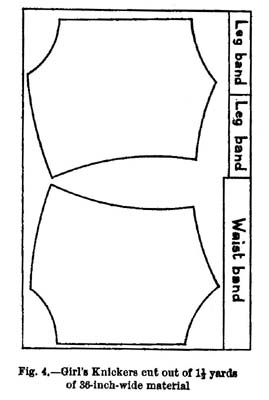 Bands—The child's knickerbockers are finished with two bands, openings being made at the sides. The opening should be about half the side length.
Bands—The child's knickerbockers are finished with two bands, openings being made at the sides. The opening should be about half the side length.
In making a girl's knickers two bands may be used, or one straight band fastening at the back.
A woman's knickers would have either a straight or (better) a shaped band. If a circular band is to be used, cut off from the pattern at waist a depth equal to the depth of the band (see dotted lines in Fig. 3).
The cutting of the circular band has already been described (see p. 272).
For all these bands a very easy waist measurement should be taken, and allowance made for turnings and overlapping. In the case of knickers with two bands a double amount should be allowed for overlapping. In dividing the total length so as to find the and front bands, allow about 1 inch more for the back than for the front.
The kneebands may be measured for, allowing plenty of room to slip over widest part of the leg; usually about ½ inch shorter than the front waistband would be sufficient for legbands, or about half the waist measure.
Making Up Knickers with Side Opening
Materials.—Cottons, flannelette, wincey, coloured gingham or zephyr, may all be used.
Seams.—Run-and-fell seams are best. The leg seams should be joined first, care being taken to pair the seams. One seam will have to be tacked from the top, the other from the knee, in order to pair them, but any difference in length must be allowed to come in both cases at the top of the seam, where the excess can easily be cut away. The two portions of the garment must next be joined by run-and-fell, the leg seams being placed exactly opposite each other first of all.
Kneebands.—The bands must be sufficiently wide to slip over the leg easily.
The knees should be gathered, stroked, and set into the kneebands, a plain piece being left on each side of the seam. As it is advisable to have most fulness in front of the leg, only a short piece should be left plain in front of the seam, and a longer piece behind it.
Another way of finishing the knees is to cut the knickers long enough to allow a frill at the knee, make a hem and perhaps two tucks, gather two rows at the top of the frill, and put a narrow band only on the right side.
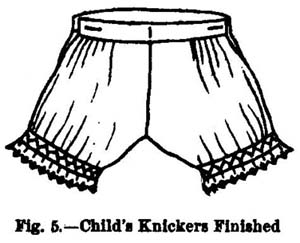
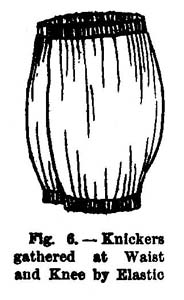 Opening.—The best way to finish the opening is the one described on p. 189, letting the back overlap the front. Narrow tapering hems may be made instead, and finished with strengthening tapes. (See p.74.)
Opening.—The best way to finish the opening is the one described on p. 189, letting the back overlap the front. Narrow tapering hems may be made instead, and finished with strengthening tapes. (See p.74.)
(For little girls' work an opening need not be made, but a hem laid all round the waist, and elastic slipped into it to gather the garment to the necessary width. The elastic would have to be placed before the hem was completely finished, or eyelet- or button-holes made through which to pass it. (Fig. 6.) The knees would be treated in the same fashion.)
Waistbands.—The waistbands being cut and prepared, the front waist of knickers should be gathered, leaving a few inches plain at either side of the seam and also near the openings. The gathers should then be stroked, and the whole front set evenly into the waistband. The back should be gathered (leaving a plain part only near the openings), stroked, and set into its band. Before beginning to gather the waist, the front and back lines should be cut even if necessary.
Fastenings.—Only button-holes are required on this garment, the buttons being on the child's stays or other garment. A button-hole is made horizontally at each end of the back band. On the front band, a horizontal buttonhole is placed at each end, and a vertical one in the middle.
Decoration.—A narrow edging may be sewn on the kneebands, or on the frill, and feather- or chain-stitching or other stitches used to the kneebands. Embroidery edging and insertion may also be used as described on p. 208.
The waistbands require no decoration, but if the garment is being sewn by machine, they may be stitched, to keep them firm and smooth. This is not necessary, however, as the button-holes help to keep the bands in.
Making Up Knickers with Band fastened at Back
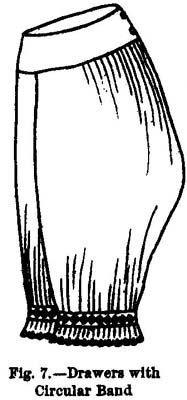 For the most part the method of making up resembles that already described. Instead of joining the legs together, narrow hems must be laid round each separate leg, and the two joined by top-sewing for a few inches from the waist
in front.
For the most part the method of making up resembles that already described. Instead of joining the legs together, narrow hems must be laid round each separate leg, and the two joined by top-sewing for a few inches from the waist
in front.
Waist.—The waist line should be gathered at the sides and back, leaving a plain part on either side of the front seam, then set into the band, which should overlap a little at the back.
Fastenings.—The band may be closed with a button and button-hole. (A circular band would require two and two button-holes.) If tape strings are used they may be sewn to each end of the band, and a button-hole made several inches from one end to allow the tapes to cross. Or one tape may be sewn to the end of the band and the other a few inches from the other end.
